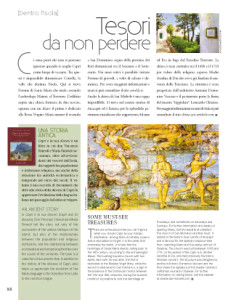 Tesori da non perdere
Tesori da non perdere
Ci sono posti che non si possono ignorare quando si sceglie Capri come luogo di vacanza. Tra questi è impossibile dimenticare Cetrella, la valle che domina l’isola. Qui si trova l’eremo di Santa Maria che risale, secondo l’archeologo Maiuri, al Trecento. L’edificio ospita una chiesa formata da due navate, ognuna con un altare: il primo è dedicato alla Beata Vergine Maria mentre il secondo a San Domenico, segno della presenza dei frati domenicani tra il Seicento e il Settecento. Nei mesi estivi è possibile visitare l’eremo di giovedì, a volte di sabato e domenica. Per avere maggiori informazioni e orari si può consultare il sito cetrella.it.
Anche la chiesa di San Michele è una tappa imperdibile. Si trova nel centro storico di Anacapri ed è famosa per lo splendido pavimento maiolicato che rappresenta Adamo ed Eva in fuga dal Paradiso Terrestre. La chiesa è stata costruita tra il 1698 e il 1719 per volere della religiosa caprese Madre Serafina di Dio che aveva già fondato il convento delle Teresiane. La struttura è stata progettata dall’architetto Antonio Domenico Vaccaro e il pavimento porta la firma del mastro “riggiolaro” Leonardo Chiaiese. Per maggiori informazioni su orari di visita si può consultare il sito chiesa-san-michele.com.
Una storia antica
Capri e la sua diocesi è un libro in cui don Vincenzo Simeoli e Maria Simeoli raccontano, oltre all’avvicendarsi dei vescovi dell’isola, dei rapporti tra popolazione e istituzione religiosa, ma anche della relazione tra autorità ecclesiastica e temporale nel corso dei secoli. Il volume è una raccolta di documenti che oltre alla storia della diocesi di Capri fa apprezzare l’evoluzione della lingua italiana nel passaggio dal latino al volgare. | An ancient story. In Capri e la sua diocesi (Capri and its diocese), Don Vincenzo Simeoli and Maria Simeoli tell the story not only of the succession of the various bishops on the island, but also of the relationships between the population and religious institutions, and the relationship between ecclesiastical and temporal authorities over the course of the centuries. The book is a collection of documents that, in addition to the history of the diocese of Capri, also helps us appreciate the evolution of the Italian language in the transition from Latin to the common tongue.
Some must-see treasures
There are some places that you can’t ignore when you choose Capri as your holiday destination. Among them is Cetrella, a place that is impossible to forget: it is the valley that dominates the island. It is here that the hermitage of Santa Maria stands, dating back to the 14th century, according to the archaeologist Maiuri. The building houses a church with two aisles, each with its own altar: the first is dedicated to the Blessed Virgin Mary, while the second is dedicated to San Domenico, a sign of the presence of the Dominican monks between the 17th and 18th centuries. During the summer months it is possible to visit the hermitage on Thursdays, and sometimes on Saturdays and Sundays. For further information and details of opening times, visit the website at cetrella.it.
The church of San Michele is another must. It stands in the historic town centre of Anacapri and is famous for the splendid majolica-tiled floor, depicting Adam and Eve being cast out of Paradise. The church was built between 1698 and 1719, on the wishes of the Capri nun, Mother Serafina di Dio, who had previously founded a Teresian convent. The structure was designed by architect Antonio Domenico Vaccaro and the floor bears the signature of the master ceramics craftsman Leonardo Chiaiese. For further information on visiting times, visit the website at chiesa-san-michele.com.





